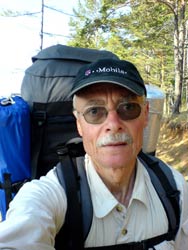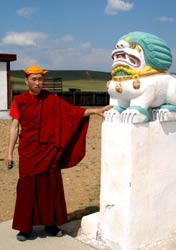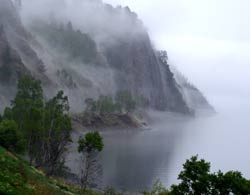Camp 1 in Naryn-Atsagat 7th - 18th June 2006
by Eberhardt Schott
 The first time I heard about the GBT project was in 2004. I knew that I would stop working within two years anyway and decided that I wanted to fulfil one of my life-long dreams: travelling to Lake Baikal. Since I think nothing of 'lazy' holidays, a working project far away from home suited me just fine. So, I applied for such a project at Baikalplan e.V. As there was an age limit for my preferred project camp 27, Ust-Barguzin), I went for the camp 1a taking place in Atsagat even though it had nothing to do with Lake Baikal. I wanted to work directly on the lake, however, after working at the camp I made a tour on my own around the southern bank of Lake Baikal so that my dream finally came true. I will report more about this journey later.
The first time I heard about the GBT project was in 2004. I knew that I would stop working within two years anyway and decided that I wanted to fulfil one of my life-long dreams: travelling to Lake Baikal. Since I think nothing of 'lazy' holidays, a working project far away from home suited me just fine. So, I applied for such a project at Baikalplan e.V. As there was an age limit for my preferred project camp 27, Ust-Barguzin), I went for the camp 1a taking place in Atsagat even though it had nothing to do with Lake Baikal. I wanted to work directly on the lake, however, after working at the camp I made a tour on my own around the southern bank of Lake Baikal so that my dream finally came true. I will report more about this journey later.
At this point it should be mentioned that me and my wife often spent our holidays in the former Soviet Union. Furthermore, I worked twice in Moscow for half a year each. This is very important regarding the impressions I got from the 'new' Russia. What I learned there is that life in Russia became harder and rougher, which in turn made an impact on the people visiting the country.
 I got to know three of the participants already before the journey. This is very advantageous as you can discuss several things in advance, for example, how to get a visa or what public transport to take.
I got to know three of the participants already before the journey. This is very advantageous as you can discuss several things in advance, for example, how to get a visa or what public transport to take.
And now to the journey:
On 1st June I flew from Berlin Tegel Airport to Domodedovo Airport, Moscow, together with Petra and Holger. In the evening we travelled on the Trans-Siberian Railway to Ulan-Bator. At the train station we had to be very though. Otherwise the train would have departed without us. Only the 'nachalnik' (the person responsible) was apparently familiar with the tickets we got from the German railway station. Finally, we got the green light for going on the train. I recommend everyone to go by train through Siberia if there's enough time. Within these 4 days you'll have enough time to leave your home and the hectic life behind and to prepare for the things and adventures to come. You can see a lot of things when looking out if the window or when being at a station. I, for one, had a great time on the train.
On 5th June we arrived in Ulan-Ude at midday (local time) where we were picked up and brought to our chosen hotel: the Buryatiya Hotel. The GBT booked the rooms for us. Thanks again for this! There, we felt a little disappointed:
1. The room was relatively expensive, 2. there was no warm water, 3. the staff were very unfriendly but 4. the hotel was centrally located with easy access to public transport.
In Ulan-Ude there was a small programme planned for us. For example, we visited the open-air museum. From Okhir we got all the help and advice we required. Without him I would have barely succeeded in converting my American Express Travellers Cheques into roubles (in cash). I recommend not to use these cheques. You can change money in any bank, or you can get it from cash machines.
 On 7th June we all met at the Lenin statue where we started our journey to Atsagat. The journey turned out be more complicated than we thought since we took public transport. So, we got in a 'marshrutka' (small bus), got off it, waited for the next 'marshrutka', got in it and so on. In the end, we put our rucksacks on our backs (mine was 18.5kg/ 40.7lb in weight when I checked in at Berlin Tegel Airport) and walked right across the town in search of a regularly used bus stop. Surprisingly, we found such a bus stop from where a bus drove directly into the wilderness of Atsagat. The journey on the Trans-Siberian Railway had already prepared us for travelling in Russia. We stayed calm and quiet. Eventually, we arrived in the 'wilderness', which I found very beautiful and interesting wilderness regarding the landscape. From a distance we saw the monastery situated on the mountain side, which was where we would work for the next 10 days.
On 7th June we all met at the Lenin statue where we started our journey to Atsagat. The journey turned out be more complicated than we thought since we took public transport. So, we got in a 'marshrutka' (small bus), got off it, waited for the next 'marshrutka', got in it and so on. In the end, we put our rucksacks on our backs (mine was 18.5kg/ 40.7lb in weight when I checked in at Berlin Tegel Airport) and walked right across the town in search of a regularly used bus stop. Surprisingly, we found such a bus stop from where a bus drove directly into the wilderness of Atsagat. The journey on the Trans-Siberian Railway had already prepared us for travelling in Russia. We stayed calm and quiet. Eventually, we arrived in the 'wilderness', which I found very beautiful and interesting wilderness regarding the landscape. From a distance we saw the monastery situated on the mountain side, which was where we would work for the next 10 days.
With good cheer and full of beans we climbed to the monastery, to the Buddhists. After we checked our accommodation we were filled with a feeling of disappointment. Everyone wanted to be alone and nobody said a word for the next few hours. We were a little shocked about the quality of the things there, (especially the beds and the kitchen), which weren't up to the standards we were used to. Looking back, any problems we had were. You just have to use your own initiative. And you have to improvise to make your life more comfortable. That's exactly the reason why such journeys are that attractive and exciting. By the way, the group was just fantastic. We were a good team in terms of the work there as well as the shaping of our leisure time.
The group consisted of Petra, Holger, Andreas and me from Germany, Zaeyra from Switzerland, Evgeni, a German language and literature studies student from Irkutsk, Okhir the interpreter (Russian, German) and Igor, our group leader.
 Our main task was to build stupas. This implied knowledge of carpentry and concrete building. By sheer coincidence we were all familiar with these thing. What a surprise! Everything went like clockwork and the work was really fun. Unfortunately, our work motivation was stopped from time to time so that we had a lot of imposed leisure time. I, for one, took the time to do long-distance walking tours.
Our main task was to build stupas. This implied knowledge of carpentry and concrete building. By sheer coincidence we were all familiar with these thing. What a surprise! Everything went like clockwork and the work was really fun. Unfortunately, our work motivation was stopped from time to time so that we had a lot of imposed leisure time. I, for one, took the time to do long-distance walking tours.
In my opinion, it wasn't the GBT team's fault that our work there was barely effective. It also wasn't the monks' fault. The only persons who have to be blamed for this are the people responsible for the monastery, i.e. the dignitaries. They just knew how to enjoy the culinary delicacies of the Buryat cuisine (which we could have also benefited from). It was a shame because all participants would have worked much more and wanted to leave more obvious marks of their work.
In spite of this, everyone enjoyed the work camp. I think, such a camp is a good opportunity to get to know interesting people and different cultures. And at the same time, you can create something that lasts. This was the story about the work project which ended on 17th June (and not on 18th June as it was originally planned) when we travelled back to Ulan-Ude.
 I, for one, had planned to travel through Siberia along Lake Baikal (finally) after the work camp until 27th June - then I wanted to fly back from Irkutsk Airport. Now I was on my own. And I want to be honest with you: I had lots of sleepless nights before the journey.
I, for one, had planned to travel through Siberia along Lake Baikal (finally) after the work camp until 27th June - then I wanted to fly back from Irkutsk Airport. Now I was on my own. And I want to be honest with you: I had lots of sleepless nights before the journey.
On 17th June I travelled non-stop by 'marshrutka' from Ulan-Ude to Slyudyanka over about 350km (218 miles) within 6 hours. In Slyudyanka I visited the mineral museum which really is worth seeing. I spent the night in the hostel that belongs to the museum.
My plan was to go by train, which operates every day, along the former Trans-Siberian Railway. I wanted to go off at the second or third station and then walk to Port Baikal. At night, I wanted to sleep in my tent. Unfortunately, the plan fell through. It was constantly raining and it was only 6-7 degrees outside. So, I had to change my plan. I decided to travel all the way to Port Baikal by train. Such a journey is to be recommended. There are a lot of beautiful things to see. However, it was a pitty, that I couldn't discover the countryside by foot. In Port Baikal, I waited for the rain to stop for two days and planned to travel by foot on the way back. But the rain didn't stop. Only on 20th June, when I had crossed the Angara River by ferry, the weather improved.
I spent a night in Listvyanka. The next day I travelled to Bolshie Koty. Now, the sun was shining and the days were scorching hot. From Bolshie Koty I travelled to Kadilnaya, the northernmost place at the western bank of Lake Baikal. From here I went straight to Irkutsk via Listvyanka and Taltsy where I visited the open-air museum.
On my tour to Kadilnaya I found what I was searching for: Pure Lake Baikal. There are no words to decribe this beauty. You have to discover this fascinating countryside on your own.

